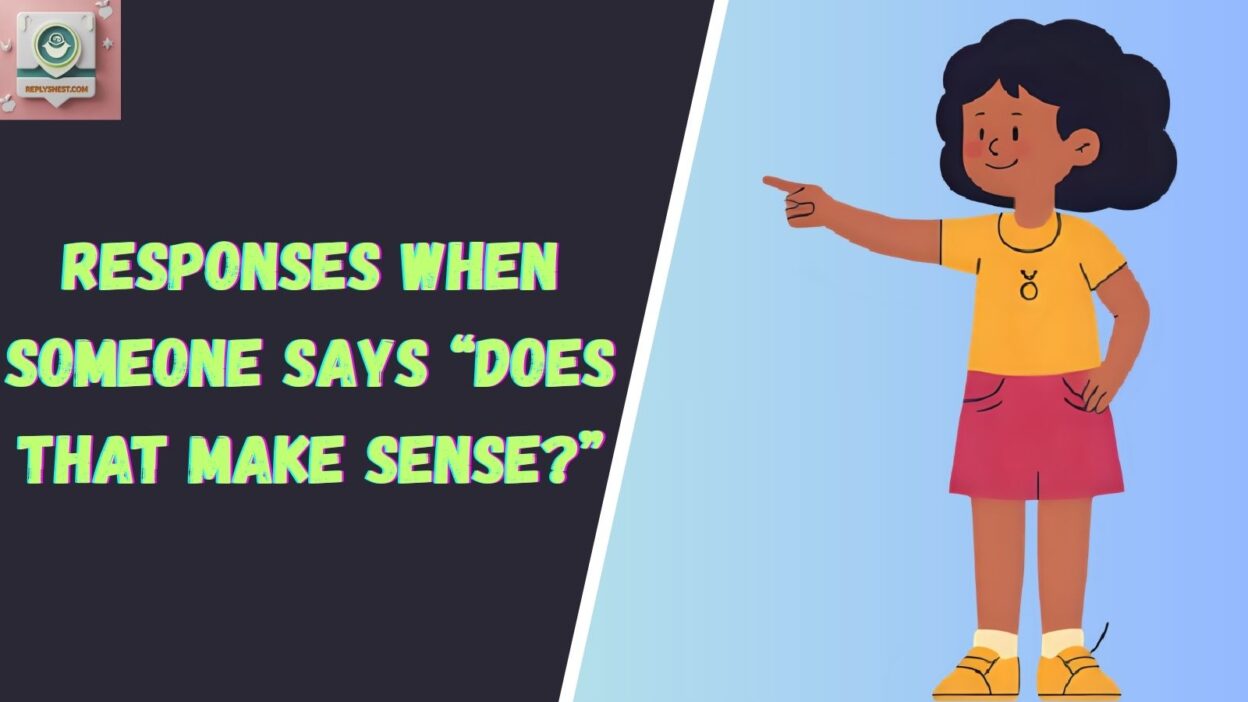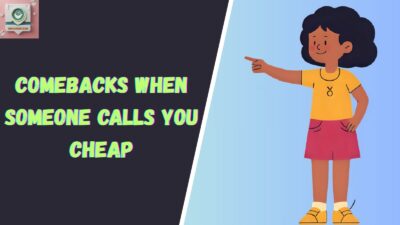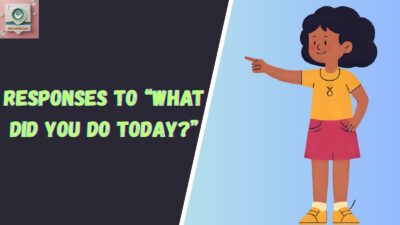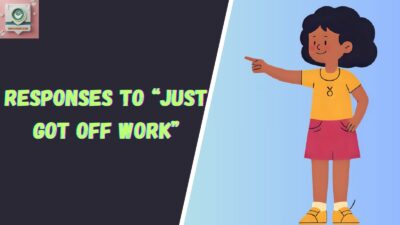When someone asks “Does that make sense?”, it’s usually because they want to check if you’ve understood them clearly. It’s not just about comprehension—it’s also about connection, reassurance, and showing respect in communication. Responding thoughtfully can make the other person feel valued and can strengthen trust. Responses When Someone Says “Does That Make Sense?”.
When someone asks, “Does that make sense?”, it can be a pivotal moment in a conversation. From my own experience in business communication, I’ve found that a direct answer like “yes” or “no” is rarely enough. If the concept is clear, you might confirm your understanding by summarizing the main points—this shows engagement and that you are following. If it’s not clear, you could politely ask for clarification, rephrase a term, or even give an example to make the information more digestible.
I once had a colleague who would slow the process down and break the topic into smaller pieces, which helped identify the most difficult section without making anyone feel unsure or as though they were just pretending they understood. It’s about saving face while still getting to the true goal better understanding.
In high-stakes meetings or during training, I’ve used helpful strategies like saying, “Let’s look at that again” or “Could you explain that in another way?” This blends politeness with professional alternatives to avoid misinterpret signals or sounding rude. Sometimes, simply stating, “I think I missed the last part, could you clarify?” makes the dialogue more dynamic and human. Using follow-ups can move the discussion forward while keeping issues in check.
I’ve noticed this approach helps create a crystal–clear picture where all the dots are connected—almost like pieces of a puzzle coming together. When the meaning is still confusing, showing empathy and acknowledging that learning and grasping new concepts takes time can make the conversation more enriching and bridge any gaps in understanding.
1. “Yes, that makes perfect sense.”
Best Use: When the explanation is crystal clear.
Not to Use: If you’re still confused—it might come off as dishonest.
Other Ways to Say: “Got it!” / “I follow you.”
Example: “Yes, that makes perfect sense. Thanks for breaking it down.”
Read More: Other Ways to Say “Don’t Be Shy”
2. “I see what you mean.”
Best Use: When you genuinely connect with their point.
Not to Use: If you’re only half-listening.
Other Ways to Say: “I get your point.” / “That clicks.”
Example: “I see what you mean, especially about how timing plays a role.”
3. “Absolutely, I’m with you.”
Best Use: When you want to confirm alignment.
Not to Use: In super formal settings—it might sound too casual.
Other Ways to Say: “I’m on the same page.” / “That works for me.”
Example: “Absolutely, I’m with you on that approach.”
4. “Yes, that’s clear.”
Best Use: In professional discussions where clarity matters.
Not to Use: If you still have questions.
Other Ways to Say: “That’s straightforward.” / “Understood.”
Example: “Yes, that’s clear. Thanks for laying it out step by step.”
5. “That explanation really helped.”
Best Use: When their effort truly clarified things.
Not to Use: If you’re still lost—it’ll sound forced.
Other Ways to Say: “Now it clicks.” / “That cleared things up.”
Example: “That explanation really helped me understand the process.”
6. “Got it, thank you.”
Best Use: Quick, polite confirmation.
Not to Use: If the conversation needs more depth.
Other Ways to Say: “Makes sense, thanks.” / “I got you.”
Example: “Got it, thank you for explaining so clearly.”
7. “Yes, it all adds up now.”
Best Use: When everything finally connects.
Not to Use: In highly formal writing—it’s more conversational.
Other Ways to Say: “Now it makes sense.” / “Everything fits together.”
Example: “Yes, it all adds up now after hearing your breakdown.”
8. “I understand where you’re coming from.”
Best Use: When showing empathy along with understanding.
Not to Use: If you don’t actually understand—it could backfire.
Other Ways to Say: “I get your perspective.” / “I see your side.”
Example: “I understand where you’re coming from about the deadlines.”
9. “Yes, that clarifies things.”
Best Use: When an earlier confusion is resolved.
Not to Use: If you’re still unclear.
Other Ways to Say: “That clears it up.” / “Thanks, now I see it.”
Example: “Yes, that clarifies things—I wasn’t sure before.”
10. “Now I get it.”
Best Use: When the final piece just clicked.
Not to Use: If you already understood from the start.
Other Ways to Say: “It makes sense now.” / “I get it now.”
Example: “Ah, now I get it—it’s about timing, not just effort.”
11. “That makes a lot of sense.”
Best Use: When you want to reinforce understanding strongly.
Not to Use: If you’re only partly convinced.
Other Ways to Say: “That sounds logical.” / “I get the logic.”
Example: “That makes a lot of sense considering the circumstances.”
12. “Yes, you explained that really well.”
Best Use: When you want to acknowledge their effort.
Not to Use: If their explanation was confusing—it’ll sound fake.
Other Ways to Say: “That was a clear explanation.” / “You broke it down nicely.”
Example: “Yes, you explained that really well—thank you.”
13. “I’m following along with you.”
Best Use: To show you’re actively engaged.
Not to Use: In very formal meetings.
Other Ways to Say: “I’m keeping up.” / “I’m tracking with you.”
Example: “I’m following along with you, and it’s making sense.”
14. “It’s coming together for me now.”
Best Use: When understanding builds gradually.
Not to Use: If you’re still completely lost.
Other Ways to Say: “It’s making sense bit by bit.” / “I’m connecting the dots.”
Example: “It’s coming together for me now after your example.”
15. “Yes, that’s logical.”
Best Use: When reasoning is sound.
Not to Use: In casual chats—it may feel stiff.
Other Ways to Say: “That adds up.” / “That’s reasonable.”
Example: “Yes, that’s logical based on the data.”
16. “Thanks, that made things clearer.”
Best Use: To show gratitude along with understanding.
Not to Use: If nothing was clarified.
Other Ways to Say: “That really helped.” / “I appreciate the explanation.”
Example: “Thanks, that made things clearer—I was overthinking it.”
17. “I follow your reasoning.”
Best Use: For intellectual or analytical discussions.
Not to Use: If you actually disagree with their logic.
Other Ways to Say: “I see your logic.” / “I get your reasoning.”
Example: “I follow your reasoning about cutting costs first.”
18. “Yes, that connects the dots for me.”
Best Use: When several scattered points come together.
Not to Use: If you’re still missing big pieces.
Other Ways to Say: “That ties everything together.” / “That links it all.”
Example: “Yes, that connects the dots for me now.”
19. “Makes perfect sense, thanks.”
Best Use: When you want to affirm quickly but warmly.
Not to Use: In extremely formal documents.
Other Ways to Say: “Got it, thanks.” / “That’s clear now.”
Example: “Makes perfect sense, thanks for clarifying.”
20. “That really cleared it up for me.”
Best Use: After confusion is resolved.
Not to Use: If you’re still confused—it’ll mislead them.
Other Ways to Say: “That fixed my confusion.” / “That untangled it.”
Example: “That really cleared it up for me—I was stuck before.”
21. “I’m on the same page now.”
Best Use: To show alignment in teamwork.
Not to Use: If you’re still out of sync.
Other Ways to Say: “We’re aligned.” / “I get what you mean now.”
Example: “I’m on the same page now—let’s move forward.”
22. “Yes, I grasp it now.”
Best Use: In semi-formal or academic contexts.
Not to Use: In super casual chats—it may sound stiff.
Other Ways to Say: “I get it now.” / “I’ve got a hold of it.”
Example: “Yes, I grasp it now after your explanation.”
23. “That’s easy to understand now.”
Best Use: When something once complicated feels simple.
Not to Use: If it still feels complicated.
Other Ways to Say: “That simplified it.” / “Now it’s straightforward.”
Example: “That’s easy to understand now with your example.”
24. “Yes, you made it very clear.”
Best Use: To acknowledge someone’s communication skills.
Not to Use: If they actually didn’t explain clearly.
Other Ways to Say: “That was well explained.” / “You put it clearly.”
Example: “Yes, you made it very clear and easy to follow.”
25. “I get the picture now.”
Best Use: When the whole situation makes sense.
Not to Use: In formal business writing.
Other Ways to Say: “I see it now.” / “I get the whole idea.”
Example: “I get the picture now—it all fits together.”
Conclusion
Responding to “Does that make sense?” is more than just saying yes or no—it’s about showing engagement, gratitude, and connection. The right response makes the other person feel heard and respected, while also reinforcing that you’re both on the same wavelength.
From my own experience in both professional and personal conversations, the more genuine and specific your response, the better the communication flows. It builds trust, clears confusion, and often even deepens relationships.
Editor’s Picks (10 Quick Favorites)
- “Yes, that makes perfect sense.”
- “I see what you mean.”
- “Absolutely, I’m with you.”
- “That explanation really helped.”
- “Got it, thank you.”
- “Now I get it.”
- “I understand where you’re coming from.”
- “Yes, that clarifies things.”
- “I’m on the same page now.”
- “I get the picture now.”



